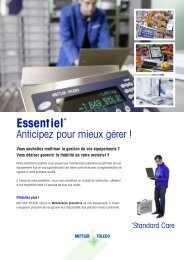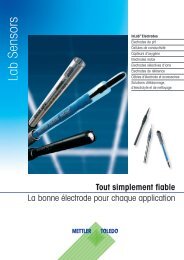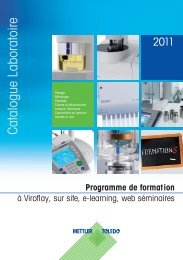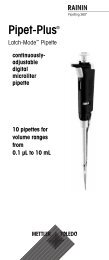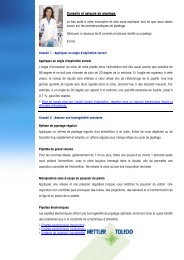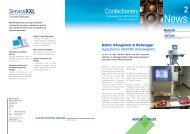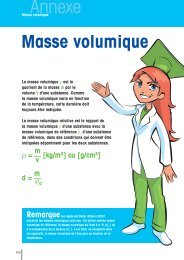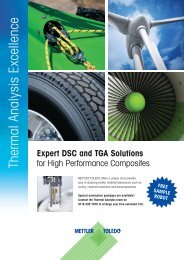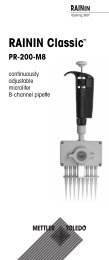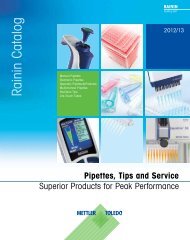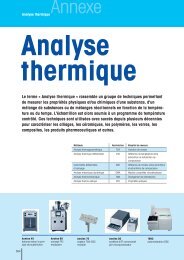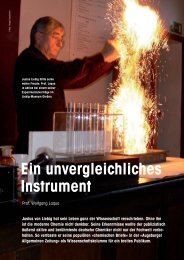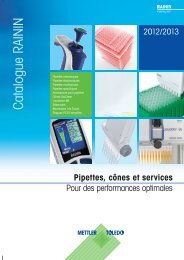GWP_P360_Winnipeg_Nov3_2010 - Home - Public Partner Portal ...
GWP_P360_Winnipeg_Nov3_2010 - Home - Public Partner Portal ...
GWP_P360_Winnipeg_Nov3_2010 - Home - Public Partner Portal ...
Create successful ePaper yourself
Turn your PDF publications into a flip-book with our unique Google optimized e-Paper software.
Today’s Schedule8:45 Overview and Introductions8:50 <strong>GWP</strong> ® -Good Weighing Practice10:30 Break10:30 <strong>GWP</strong> ® -Good Weighing Practice12:15 Minimizing Weighing Measurement Uncertainty using LabX ®12:15 Lunch & Laboratory Solutions ExpositionCopyright <strong>2010</strong> Mettler-Toledo, Inc.
Today’s Subject Matter Experts• Henry OppermannFormer Div. Chief, Weights & MeasuresNat‘l Inst. Standards & Technology [NIST]O: 504.896.9172eMail: [wm-consulting@att.net]• Michael BirtzuService Leader – LabLab Service CanadaM: 519.856.9297eMail: [michael.birtzu@mt.com]• Bryce MichelRegional Sales Mgr.RAININO: 510.564.1600 x237eMail: [bryce.michels@rainin.com]• Sam SakherInstruments Sales SpecialistTitration, Density, & RefractometryM: 630.235.3807eMail: [mike.guyer@mt.com]• Hubert CanigliaLaboratory Sales SpecialistWeighing & pHM: 416.994.9210eMail: [hubert.caniglia@mt.com]• Eddie Isidto JrLiquid Handling Sales SpecialistRAININO: 604.790.5229eMail: [eddie.isidto@rainin.com]Copyright <strong>2010</strong> Mettler-Toledo, Inc.
Our GroupMETTLER TOLEDO is a global manufacturerand marketer of precision instruments foruse in the laboratories, manufacturing, andfood retailing.< Worldwide presence< 8’000 employees< Sales approx.USD 2.0 billion3Copyright <strong>2010</strong> Mettler-Toledo, Inc.
Who we are: Our SolutionsLaboratory Solutions:Industrial Instruments:Retail Solutions:Copyright <strong>2010</strong> Mettler-Toledo, Inc.
Strength – MT GroupWhy METTLER TOLEDO?• The four most frequently calibrated instruments in the lab are:- Balances- Pipettes / Liquid Handling- pH Meters- Weights• METTLER TOLEDO and RAININ are the Global leaders in all four- The only national supplier of factory direct calibration on our products• Use our 100+ years of expertise to improve your processes- End-user seminars- Consultative services – Asset Management - <strong>GWP</strong>® - Pipette 360®- Regulatory compliance• Recognized as the technology innovators and subject matter experts byregulatory authorities5Copyright <strong>2010</strong> Mettler-Toledo, Inc.
Is Weighing a Risk ?This seminar will cover weighing risks and how tocontrol and minimize the sources of risk7Copyright <strong>2010</strong> Mettler-Toledo, Inc.
Weighing comes of age…"Papyrus of Ani“ — The Weighing of the Heart Against the Feather of Truth, circa 1250 BC (Painted Papyrus)8Copyright <strong>2010</strong> Mettler-Toledo, Inc.
How can mass be measured?Use the ubiquituous gravity on Earthg ≈ 9.81N/kgIsaac Newton (*1643-†1727):Weight force is PROPORTIONAL to MASSF G=m ⋅ g9Copyright <strong>2010</strong> Mettler-Toledo, Inc.
Compensation principlem·g =10Copyright <strong>2010</strong> Mettler-Toledo, Inc.
Electrodyn. compensating analytical balance1 weighing pan2 hanger3 guide4 flexible joint5 coupling6 lever7 lever bearing8 compensation coil9 permanent magnet10 magnetic flux11 optical position sensor12 position vane13 temperature sensor11Copyright <strong>2010</strong> Mettler-Toledo, Inc.
Cut open view of a semi-micro balance (0.01mg)12Copyright <strong>2010</strong> Mettler-Toledo, Inc.
Good Weighing Practices ®Protecting your investment, minimizing risksCopyright <strong>2010</strong> Mettler-Toledo, Inc.
Calibration by Service TechnicianBenefits• Assesses complete balance performanceby testing all relevant weighing parameters• Determines measurement uncertaintyand minimum weight• Provides accredited and traceable certificatesaccording to ISO17025/USP/A2LALimitations• Unknown status of balance betweencalibrations if not performed frequently• High costs if performed frequently14Copyright <strong>2010</strong> Mettler-Toledo, Inc.
Routine Testing by UserBenefits• Easy and rapid control of requiredaccuracy• Immediate detection of critical deviations• Minimizes risks by testing at appropriateintervals in-between the calibrationsLimitations• Incomplete testing of balancecharacteristics15• Weights have to be re-calibratedperiodicallyCopyright <strong>2010</strong> Mettler-Toledo, Inc.
Internal Safety Features of BalancesWithoutInternalAdjustmentWithBenefits• Automatic adjustment eliminates driftand corrects temperature effects, thusincreasing weighing accuracy• Reduces costs and effort becausebalances with auto-adjustment /calibration require less routine testsLimitations• Weights formally not traceable tonational or international standards16• Cannot detect repeatability oreccentricity errorsCopyright <strong>2010</strong> Mettler-Toledo, Inc.
Functionality of Auto-Calibration / Adjustment• At the end of the assemblyprocess in the factory, the builtinweight of the balance is beingcalibrated with an externalreference weight (“primaryreference calibration”).• The value of this calibration isstored in the memory of thebalance. The built-in weight isused to calibrate or adjust thesensitivity of the balance duringany subsequent auto-calibration/ adjustment.17Copyright <strong>2010</strong> Mettler-Toledo, Inc.
Routine Operation – SummaryAssessment of complete balanceperformance by testing all relevantweighing parameters incl. built-in safetyfeatures (e.g. auto-calibration)instrument drivenAssessment of weighing accuracyrequirementsprocess drivenCompensation of external (temperature)and internal influences (drift)environment driven18Copyright <strong>2010</strong> Mettler-Toledo, Inc.
Good Weighing Practices ®Understanding the MetrologyCopyright <strong>2010</strong> Mettler-Toledo, Inc.
Speedometer accuracyThe readability of this speedometer is 10 km/h• This speedometer might be accurate to 10 km/h.20Copyright <strong>2010</strong> Mettler-Toledo, Inc.
Smaller readability — higher accuracy?The readability of this speedometer is 2 km/h• Is this speedometer is 5 times more accurate than the previous one?After all, it is still the same instrument...21Copyright <strong>2010</strong> Mettler-Toledo, Inc.
Measurement uncertainty – what is it?Uncertainty of Measurement” […] parameter characterizing the dispersion of the quantity values beingattributed to a measurand […].”International Vocabulary Of Basic And General Terms In Metrology (VIM) JCGM200:2008, item 2.26• Measurement uncertainty recognizes the reality that no measurementis perfect• Measurement uncertainty tells, how accurate the measuredvalue is – how close it is to the target value• Stating measurement uncertainty forms part of aquality systems such as ISO, GLP/GMP, orpharmacopeias, such as USP• The accuracy of measurements can bechallenged during an inspection andmust be documented22Copyright <strong>2010</strong> Mettler-Toledo, Inc.
Main contributions to weighing uncertaintyBalance properties essential to weighing uncertainty:SensitivitySENonlinearityNLEccentricityECRepeatabilityRPA single measurement is never “TRUE” but lies within the rangeof values that are within +/- the measurement uncertainty!23Copyright <strong>2010</strong> Mettler-Toledo, Inc.
Estimating weighing uncertaintyISO Guide to the Expression of Uncertainty in Measurement [GUM]:-three steps are required to estimate uncertainty:• 1 st Step:•Obtain standard uncertainties of individual contributioninfluence- repeatability (RP)- eccentricity (EC)- linearity (NL)- sensitivity deviation (SE)24Copyright <strong>2010</strong> Mettler-Toledo, Inc.
Where do I get these values from?• From- specifications (data sheet, DQ)- in-situ measurements with the balance (OQ, PQ)• Why is the contribution of readability (RD) not considered?- Repeatability, if experimentally determined, comprises readability;- If by chance all readings are equal, set repeatability tos 4dRP = 0.where d is the readability.25Copyright <strong>2010</strong> Mettler-Toledo, Inc.
Combining uncertainty contributions• 2nd Step:Combination of (standard) uncertainties:2RP2EC2NLu = u + u + u +u2SE26Copyright <strong>2010</strong> Mettler-Toledo, Inc.
Measurement Uncertainty• 3rd Step:Expansion of uncertainty:• expansion factor:- choice of a suitable expansion factor k8k = 2 ~95% confidence (assuming normal distribution)8k = 3~99.7% confidence (assuming normal distribution)27Copyright <strong>2010</strong> Mettler-Toledo, Inc.
Properties influencing weighing accuracyBalance properties contributing to weighing uncertainty:SensitivitySENonlinearityNLEccentricityECRepeatabilityRP28Copyright <strong>2010</strong> Mettler-Toledo, Inc.
Components of weighing uncertaintyAnalytical balance200g; 0.1mgUm0Stransition region(roll off)C 2Uncertainties based ontypical specificationsrepeatability dominates uncertainty29sensitivity & eccentricitydominate uncertaintyCopyright <strong>2010</strong> Mettler-Toledo, Inc.
Summary: Influence of weighing propertiesRepeatability- Dominant influence with samples of small mass*)Sensitivity & Eccentricity- Dominant influence with samples of large mass*)- Negligible influence with samples of small massNonlinearity- Not dominant with samples of small mass*)- Generally not dominant within the entire range of samplemass_________________*) compared to the capacity of the balance30Copyright <strong>2010</strong> Mettler-Toledo, Inc.
Mass of Test WeightsWeight 1Largest OIML or ASTM denomination which equalsor is smaller than the capacity of the balancem ≤ cap T1200 gSemimicrobalance200 g4 kgPrecisionbalance2 kgWeight 2Largest OIML or ASTM denomination which equalsor is smaller than 5% of the capacity of the balance(smaller than a mass in the transition region)m1T2 ≤ 20 cap10 g200 g31Copyright <strong>2010</strong> Mettler-Toledo, Inc.
Which test weight for sensitivity?• Test sensitivity with weight close to nominal capacity (Weight 1)• Using a smaller test weight (‘a’) results in a smaller detectable offset.The measurement is distorted by repeatability (pink band)• Using an even smaller test weight (‘b’) results in the detectablesensitivity offset being buried entirely in the deviations of repeatabilitygood detectabilitycharacteristic curve withsensitivity deviationcorrect sensitivity (=1)poor detectabilityWrongnot detectableWeight 2: FeasibleWeight 1: Bestb 32anomLoad (not to scale)Copyright <strong>2010</strong> Mettler-Toledo, Inc.
Frequency of user tests: sensitivitymore frequentless frequent• Sensitivity calibration is an integral part of the functional control of ameasurement device• Sensitivity tests are simple and fast• For a balance with activated auto calibration, sensitivity calibrations withexternal weights can be carried out less frequently33Copyright <strong>2010</strong> Mettler-Toledo, Inc.
Repeatability analyzedAnalytical balance200g; 0.1mgrepeatability remains virtually constantdifficult tohandleWeight 2:easy to handleUncertainties based on typical specifications34Copyright <strong>2010</strong> Mettler-Toledo, Inc.
Frequency of user tests: repeatabilitymore frequentless frequent• The repeatability is the important property when weighing small samples,and hence, where required, for the determination of the minimal samplemass that can be considered within process requirements• Repeatability should be performed by a well trained individual, as a poorrepeatability test may give an artificially large uncertainty value35Copyright <strong>2010</strong> Mettler-Toledo, Inc.
Nonlinearity analyzedAnalytical balance200g; 0.1mgFor laboratory balances, nonlinearity isinsignificantUncertainties based on typical specifications36Copyright <strong>2010</strong> Mettler-Toledo, Inc.
Nonlinearity testIndication• Nonlinearity does not play asignificant role with laboratorybalances.• Thus, the user does not have totest nonlinearity.• Nonlinearity is assessed in theframework of maintenance by anaccredited service technician.LoadNB. The linearity deviation is of little importance for the sample result. This is why a balance failing linearity, yet passingSE, RP and EC is still a “Pass”, and may continue to be kept in operation.37Copyright <strong>2010</strong> Mettler-Toledo, Inc.
Frequency of user tests: non-linearity• The influence of non-linearity on the weighing result is negligible• In the case of laboratory balances, it is justified to leave the determination ofnonlinearity to the service technician38Copyright <strong>2010</strong> Mettler-Toledo, Inc.
Eccentricity analyzedAnalytical balance200g; 0.1mgIf any, eccentricityplays only a rolefor samples with alarge massWeight1:Best39Uncertainties based on typical specificationsCopyright <strong>2010</strong> Mettler-Toledo, Inc.
Eccentricity test weight• Test eccentricity with a testweight close to nominalcapacity.Weight 140Copyright <strong>2010</strong> Mettler-Toledo, Inc.
Frequency of user tests: eccentricitymore frequentless frequent• Eccentricity may play a role if the tare vessel is removed for filling;due to changing location• Eccentricity may also be important at higher loads, if the tare vessel is placednon-centrically on the pan• Eccentricity may be suppressed by centering the load on the platform each timeit is weighed• Use of suitable accessories alleviates eccentricity (Ergoclips)41Copyright <strong>2010</strong> Mettler-Toledo, Inc.
Dedicated pan, draft shield counter impact42Copyright <strong>2010</strong> Mettler-Toledo, Inc.
Summary: Test weights for user testsSensitivity Repeatability EccentricityifrequiredWeight 1Weight 2Weight 2 Weight 143Copyright <strong>2010</strong> Mettler-Toledo, Inc.
Weight NormsWeight Classes are dictated by:- OIML R 111-1 (classes E1, E2, F1, F2, M1, M2, M3)http://www.oiml.org/publications/- ASTM E-617 (classes 0, 1, 2, 3, 4, 5, 6, 7)http://www.astm.org/Standards/E617.htm- NIST HB105-1 (NIST Class F)- Caution: OIML M1, M2 and M3 and ASTM 5, 6 and 7are not suitable in a laboratory environment, as they are allowed to have aporous surface, a potential danger for contamination44Copyright <strong>2010</strong> Mettler-Toledo, Inc.
Good Weighing Practices ®Factors affecting Measurement UncertaintyCopyright <strong>2010</strong> Mettler-Toledo, Inc.
Common influences on weighings• Potential influences that frequently cause problems when weighing:- ambient climate- air currents & pressure fluctuations- heat radiation- mechanical influences- electromagnetic influences- long-term drift- air buoyancyThe result of all influences: A deterioration in Precision (Repeatability)46Copyright <strong>2010</strong> Mettler-Toledo, Inc.
Temperature difference• If a weighing object is not at the sametemperature compared to its ambient air, an aircurrent emerges along the surface of the object• Because of viscous friction, an upward ordownward force acts upon the weighing object,making it seem lighter or heavier• Consequence: repeatability and trueness ofweighing value deteriorateCountermeasures• Weigh only objects that have the sametemperature as the balance• Let objects acclimate next to the balance, or inthe draft shield47Copyright <strong>2010</strong> Mettler-Toledo, Inc.
Absorption / evaporation• The mass of hygroscopic, volatile or reactiveobjects does not remain constant, as theyexchange mass with the environment• Consequence: the weighing value drifts- either negative (volatile)- or positive (hygroscopic)Countermeasures• Keep such substances sealed- e.g., in a weighing container• Keep the container closed at all times• Quickly capture weighing value48Copyright <strong>2010</strong> Mettler-Toledo, Inc.
Air currents• Air currents generate, through impact pressure or viscous friction, spuriousforces onto the weighing platform and the weighing object• Consequence: repeatability of weighing value deteriorates49Copyright <strong>2010</strong> Mettler-Toledo, Inc.
Air currentsCountermeasures• Avoid air currents• Deflect flow of air conditioners• Avoid air stream of cooling fans• Use balance with draft shield• Use a weighing platform withsmall area• If possible, use objectswith small surface and/orsmall extension(e.g., small vessel instead of alarge)50Copyright <strong>2010</strong> Mettler-Toledo, Inc.
Heat radiation• Heat radiation disturbs the thermal equilibrium of a balance and causesindication errors- The sun is one of the most frequent, especially strong and highly varying heat source- Incandescent light sources (spots) or other devices or equipment, emitting radiation,belong to this category- The operator’s body radiates sufficient heat to disturb the weighing on an analytical ormicrobalance51Copyright <strong>2010</strong> Mettler-Toledo, Inc.
Heat radiation of a human body52Copyright <strong>2010</strong> Mettler-Toledo, Inc.
Heat radiation (II)Countermeasures• Avoid heat sources (sun, lamps, radiators, etc.)• Use semi-micro and microbalances equipped with heat repellent draft shields• Wear a lab coat to lower your body’s surface temperature53Copyright <strong>2010</strong> Mettler-Toledo, Inc.
Level Condition• Changing the level of an electronic balance has two consequences:- Weight force diminishes- The lever system / guides of a balance weigh cell exhibit a mechanical torque, andthe inclination angle moves the zero point and affects the precisionCountermeasures• Install balance on stablebench• Level the balance• Use balance with levelsensor54Copyright <strong>2010</strong> Mettler-Toledo, Inc.
Vibration• Vibrations (translational as well as rotational) at the site of the balance mayintroduce deviations into the weighing value• The smaller the readability of a balance, the more susceptible it is to vibration• Consequence: repeatability of weighing value deteriorates, sometimes a biasmay occurCountermeasures• Install balance in a quietenvironment• If required, use aspecially designedweighing table55Copyright <strong>2010</strong> Mettler-Toledo, Inc.
Electrostatic charge• An electric charge sitting on an object being weighed will cause an attractionforce• Electrically nonconductive objects, e.g.containers from borosilicate glass orplastic, are prone to electrostatic pickup• Charges build up mostly throughseparation of, or friction between, twobodies• Dry powders etcCountermeasures• Put the vessel into an electricallyconducting container (shield)• Use ionized air to discharge theobject56Copyright <strong>2010</strong> Mettler-Toledo, Inc.
Magnetic influence• Magnetic forces may emerge between two bodies, if- one of them is magnetized and the other magnetically permeable- both are magnetized• Earth produces a magnetic field• Magnetic stirrers are magnetized bydefinition57Copyright <strong>2010</strong> Mettler-Toledo, Inc.
Magnetic influenceCountermeasures• If possible, avoid magnetically permable materials (e.g., iron, steel)• If possible, avoid magnetizable materials (e.g., magnetic stirrers)• Always put the object with the sameorientation in the same place• Put a non-magnetic spacer betweenobject and weighing platform(to gain distance)• Use a magnetically shielding weighingplatform58Copyright <strong>2010</strong> Mettler-Toledo, Inc.
Air buoyancy• According to Archimedes’ law, a body receives abuoyant force equal to the weight of the fluid itdisplaces• Weighments (usually) take place in air, so theobject being weighed is lifted by airW≅m⎜⎛ 1 −⎝ρ aρ⎞⎟⎠• Deviation of balance reading due to buoyancyeffect- aqueous solution (1 g/cm 3 ): ≈ –0.1%- object with density 2 g/cm 3 : ≈ –0.05%- object with density 8 g/cm 3 : 0%(due to sensitivity adjustment with a buoyantreference mass of density 8 g/cm 3 )59Copyright <strong>2010</strong> Mettler-Toledo, Inc.
Risk management equals accurate weighing!EvaluationRoutine OperationSelectionCalibrationInstallation60Copyright <strong>2010</strong> Mettler-Toledo, Inc.
Good Weighing Practices ®Risk Assessment, Monitoring, and ToolsCopyright <strong>2010</strong> Mettler-Toledo, Inc.
<strong>GWP</strong>Base Installed Base: Major Concerns• Balance performancesuitable• Performance verificationactivities suitable• Documentationcompletebackground informationavailable• Overview of the statusof installed base62Copyright <strong>2010</strong> Mettler-Toledo, Inc.
<strong>GWP</strong>Base Summary Report63Copyright <strong>2010</strong> Mettler-Toledo, Inc.
Customers’ Key Requirements<strong>GWP</strong>ExcellenceMarket InfoCust ReqSafetyAutomatic Test CallBalance Always ValidThree keyareas ofCustomerRequirementsEfficiencyCorrect Test WeightLIMS External TestingSelf-defined Test PointsGuided WorkflowPreparation InstructionsLimit Test AttemptsDuplicate Weight SizesMany Built-in Test MethodsTare Weight SimulationComfortWeight ManagementTest IntervalsService Pre-WarningWeight Certification ReminderManaging Change<strong>Home</strong>64Copyright Back <strong>2010</strong> to RequirementsMettler-Toledo, Inc.
<strong>GWP</strong>Excellence<strong>GWP</strong>ExcellenceProduct InfoFeature-BenFeatures:Weight ManagerTest Sequence ManagerTask Manager<strong>GWP</strong> HistoryService Pre-Warning MethodLevelControlMinWeighUser Management<strong>GWP</strong>Excellence<strong>Home</strong>65Copyright <strong>2010</strong> Mettler-Toledo, Feature List Inc.
Good Practices:Pipette Techniques, Applications,and CalibrationSolutions Seminar & ExpositionBryce Michel<strong>Winnipeg</strong>, MBNovember 3 rd . <strong>2010</strong>All material Copyright <strong>2010</strong> byMettler-Toledo, Inc. Thefollowing material may not bereprinted or published withoutthe express prior permissionof METTLER TOLEDO.Copyright <strong>2010</strong> Mettler-Toledo, Inc.
Agenda• Pipetting techniques- Functionality overview- Basic techniques- Errors and possible results• Choosing the right pipette- Air vs. positive- Solution property considerations- Guidelines• Choosing the right tip- Design- Quality- Fit• Calibration and Preventative Maintenance67Copyright <strong>2010</strong> Mettler-Toledo, Inc.
Basic Pipetting Techniques68Copyright <strong>2010</strong> Mettler-Toledo, Inc.
Air-Displacement PipettesPistonShaftAir SpaceDisposable TipSample69Copyright <strong>2010</strong> Mettler-Toledo, Inc.
The Pipetting CycleDepressHoldTip EjectionAspirateDispense andBlowout70Copyright <strong>2010</strong> Mettler-Toledo, Inc.
Typical Pipette Specifications• Accuracy- Typically +/- 1%• Precision:- Typically 0.25% to 0.33%- Generally wider specifications for MicropipettesNot precise nor accurate Precise but not accurate Precise and accurate71Copyright <strong>2010</strong> Mettler-Toledo, Inc.
Pipetting Techniques• Volume• Tip immersion• Aspiration• Dispensing• Consistency• Hand-warming effects˘ Errors from poor technique can range from 0.1% to 5% or more72Copyright <strong>2010</strong> Mettler-Toledo, Inc.
Impact of Errors• Errors greater than1%- Everyone needs to be aware of these errors• Errors 0.6% -1%- Normal users need to decidethe importance of each error versus the extra requirement• Errors less than 0.5%- Calibrators need to be awareas all errors can impact results73Copyright <strong>2010</strong> Mettler-Toledo, Inc.
Optimizing Volume Range• Normal Range at nominal 10% - 100% of nominal volume- Operating at 10% range requires good technique• Optimized Range typically 35% - 100% of volume- Less technique dependent- Assures accuracy and precision100%35%10%˘ Optimizing volume range improves accuracy by up to 12%74Copyright <strong>2010</strong> Mettler-Toledo, Inc.
Setting the Micrometer• Approach each volume in the same directioneach time• Turn micrometer 1/3 revolution above desiredvolume• “Dial-down” to volume setting˘ Correctly setting the volume improves accuracy by up to 0.5%75Copyright <strong>2010</strong> Mettler-Toledo, Inc.
Tip Immersion AngleCorrect immersion angleIncorrect immersion angle˘ Aspirating with correct angle improves accuracy by up to 0.5%(on microvolume up to 2.5%)76Copyright <strong>2010</strong> Mettler-Toledo, Inc.
Tip Immersion DepthPipette sizeImmersion depth2 and 10 µL 1 mm20 and 100 µL 2-3 mm200 and 1000 µL 3-6 mm5000 µL and 10 mL 6-10 mmDepth˘ Correct immersion depths improve accuracy by up to 1%(on microvolume up to 5%)Copyright <strong>2010</strong> Mettler-Toledo, Inc.
Tip Immersion Time• Maintain tip immersion time of 1 second (minimum) after aspirating• Withdraw tip slowly, smoothly from liquid source• Important for large volume samples and viscous liquid samples78Copyright <strong>2010</strong> Mettler-Toledo, Inc.
Pre-Rinsing Pipette Tips• Pre-rinse tip with sameliquid that is being dispensed• Aspirate with tip, and thendispense back into reservoiror to waste• Pre-rinsing provides identicalcontact surfaces for all aliquots79Copyright <strong>2010</strong> Mettler-Toledo, Inc.
Benefits of Pre-Rinsing100.2100.1NormalizedVolume(%)100P-10P-200P-100099.999.80 1 2Number of Pre-rinses˘ Two pre-rinses provide up to 0.2% greater accuracy whenused with aqueous liquids80Copyright <strong>2010</strong> Mettler-Toledo, Inc.
Aspiration Rate Effects• Use consistent• Pipetting rhythm• Pressure on plunger• Speed and smoothness• Aspiration too quickly causes- Liquid splash-up into shaft8Piston and seal damage- Introduction of aerosols8Sample cross-contamination˘ Incorrect aspiration affects accuracy by up to 5% or more81Copyright <strong>2010</strong> Mettler-Toledo, Inc.
Dispensing Technique• Thin-wall, FinePoint TM tips providemaximum droplet dispensing• Three techniques- Along side-wall- Above vessel/ liquid surface- Directly into liquid˘ Correct dispensing technique improves accuracy by up to 1%82Copyright <strong>2010</strong> Mettler-Toledo, Inc.
Hand-Warming Effects1002.01001.0N o rm a lize d vo lu m e1000.0999.0998.0997.0P-1000 (PVDF Handle)Leading Brand 1000uL(Polypropylene Handle)996.0995.000:0002:3204:5707:3410:06Elapsed time (mins.)12:4315:1917:4920:14˘ Prolonged hand-warming brings errors of up to 0.2% for a highqualitypipette, up to 0.5% for others83Copyright <strong>2010</strong> Mettler-Toledo, Inc.
Pipetting Techniques SummaryError Size Typical Error % TechniqueLarge up to 5.0%• Tip Immersion Depth/Angle (microvolume)• Aspiration Rate (splash up)Medium up to 1.0%Small up to 0.5%• Optimizing Volume Range• Tip Immersion Depth• Aspiration Rate (inconsistency)• Dispensing Technique• Micrometer setting (if volume range optimized)• Tip Immersion Angle• Pre-rinsing• Hand-warming84Copyright <strong>2010</strong> Mettler-Toledo, Inc.
ApplicationPipettesChoosing the right instrument85Copyright <strong>2010</strong> Mettler-Toledo, Inc.
Selecting the Right Pipette• Macro vs. Glass• Electronic• Multichannel• Dispenser & Pipetting aid• Positive displacementalso• Solution properties• Application guideline86Copyright <strong>2010</strong> Mettler-Toledo, Inc.
Macro vs. Volumetric or Serological Pipettes• Volumetric glass specs range- 0.15% - 0.6% Class A- 0.3% - 1.2% Class B- Serological 2% - 4% if at all• Air-displacement pipettes available up to 20mL- accuracy spec 1%- Empirical studies show comparable performance to Class A• Air-displacement advantage- No meniscus reading- No 5 – 25 second minimum outflow time per sample- No glass breakage- No contamination from previous washing- Low cost disposable87Copyright <strong>2010</strong> Mettler-Toledo, Inc.
Electronic Pipettes• Consistent pick-up and delivery- Using a stepper motor- Trigger instead pf plunger- Eliminates most user techniquevariability- Automatic Linerarity Correction(ALC)• Various modes- Multidispensing- Dilute, titrate- Measure, mix- Selectable speeds(e.g. slow, for viscous liquids)88Copyright <strong>2010</strong> Mettler-Toledo, Inc.
Multichannel Pipettes• High-throughput applications- ELISA – enhanced protein binding- PCR for DNA synthesis• Increased productivity- Ergonomic design- Fast tip loading• 8-,12-, 2x8 or 2x12- channels;- Manual or electronic- Various volume ranges:10, 20, 50, 200, 300 and 1200 µL89Copyright <strong>2010</strong> Mettler-Toledo, Inc.
Dispenser & Pipetting Aid• Repetitive Dispensing- Quick- Precise, accurate & even- Effortless• Flexible- Manual or electronic- Choice of volumes- Choice of tips• Pipetting aid- Special applications- Large volumes90Copyright <strong>2010</strong> Mettler-Toledo, Inc.
Positive vs. Air Displacementshaftpistonshaftdisposablepistondisposablecapillarydisposabletipair spacepistonsealsamplesamplePositive displacement PipetteAir displacement Pipette91Copyright <strong>2010</strong> Mettler-Toledo, Inc.
Positive-Displacement Pipette• Typical applications- Non-aqueous solutions- Dense or viscous- Volatile liquids- PCR8Zero contamination8Critical applications92Copyright <strong>2010</strong> Mettler-Toledo, Inc.
Solution Properties• Temperature• Density• Volatility• Viscosity93Copyright <strong>2010</strong> Mettler-Toledo, Inc.
Solution Temperature Effects106104P-1000NormalizedVolume(%)102100100 µL500 µL1000 µL9820 25 30 35 40Temperature o C˘ Solution temperature effects can result in errors of up to 5%94Copyright <strong>2010</strong> Mettler-Toledo, Inc.
Pre-rinsing and Solution Temperature• Don’t pre-rinse- When pipetting very cold (e.g. ice bath)- When pipetting with warm solutions (37 o C)• Consider using a positive-displacement pipette˘ Pre-rinsing warm or cold solutions resultsin errors of up to 5%No pre-rinse if solution is hot or cold95Copyright <strong>2010</strong> Mettler-Toledo, Inc.
Reverse Mode Pipetting• Used for viscous liquids• Blow-out stroke usedduring aspiration• No benefit for aqueous solutions96Copyright <strong>2010</strong> Mettler-Toledo, Inc.
Guidelines for Aqueous SolutionsLiquidPropertiesDesiredResultAirDisplacementPositiveDisplacementAqueous(ambient T o )AccuracyPrecisionMeets SpecificationsMeetsSpecifications*Aqueous(non-ambient T o )AccuracyPrecision•Don’t Pre-Rinse•Equilibrate Pipetteand Tips toTemperatureMeetsSpecifications** Positive displacement specifications are slightly wider than air displacementdue to the disposable capillary and piston97Copyright <strong>2010</strong> Mettler-Toledo, Inc.
Guidelines for Non-Aqueous SolutionsLiquidPropertiesDesiredResultAirDisplacementPositiveDisplacementDense(e.g. DMSO)AccuracyPrecisionEmpirically ResetVolumeMeets SpecificationsMeetsSpecificationsViscous(e.g. glycerol)AccuracyPrecisionUse Reverse ModeTechniqueMeetsSpecificationsVolatile(e.g. acetone)AccuracyPrecisionNot RecommendedMeetsSpecifications98Copyright <strong>2010</strong> Mettler-Toledo, Inc.
Applications Summary• Macro vs. Glass• Electronic- Consistent pick-up and delivery- Eliminates most user technique variability• Multichannel- High-throughput applications• Dispenser & Pipetting aid- Repetitive Dispensing• Positive displacement- Non-aqueous solutions- Dense, viscous or volatile- PCRalso• Solution properties- Temperature, Density, Volatility, Viscosity• Application guideline99Copyright <strong>2010</strong> Mettler-Toledo, Inc.
The Tips DO MatterTipsChoosing the right equipment100Copyright <strong>2010</strong> Mettler-Toledo, Inc.
Choosing the Right Tip• Design- Wall thickness- Effect on accuracy & precision- Specialty tips• Quality- Material- Contamination• Fit- Traditional- Developments101Copyright <strong>2010</strong> Mettler-Toledo, Inc.
Tip Design• Thin wall, fine point tips improve accuracy and precision• Advanced design tips have thin walls, narrow orificesStandard Beveled Thin-wall,FinePoint 102Copyright <strong>2010</strong> Mettler-Toledo, Inc.
Specialty Tip DesignFilterPistonCapillaryGel-Well Wide Orifice Filter Tips Capillaryand Piston103Copyright <strong>2010</strong> Mettler-Toledo, Inc.
Clean Production• No contamination- Staff procedures and training (ISO 9001)- Clean packaging- Automated material handling- Inspection- Clean room environment (Class 100‘000)- Certification104Copyright <strong>2010</strong> Mettler-Toledo, Inc.
Traditional Tip Fit•Traditional Tip-Cone-in-Cone shapes-Large Sealing Area-Thick-wall Tips105Copyright <strong>2010</strong> Mettler-Toledo, Inc.
Ergonomic LTS Tip Fit•Light-Touch Tip-ejection System (LTS) Tip-Cylindrical Shape of Tip and Shaft-Small, Efficient Seal-Positive Stop-Thin-wall FinePoint TM106Copyright <strong>2010</strong> Mettler-Toledo, Inc.
Tips Summary• Design- Wall thickness8 Fine point- Effect on accuracy & precision8 Significant- Specialty tips8Application specific• Quality- Material8Virgin polypropylene- Contamination8Bioclean• Fit- Traditional8High forces- Developments8Light Touch System (LTS)107Copyright <strong>2010</strong> Mettler-Toledo, Inc.
Errors in PipettingError Size Typical Error % TechniqueLarge up to 5.0%Medium up to 1.0%Small up to 0.5%• Tip Immersion Depth/Angle(microvolume)• Aspiration Rate (misuse)• Solution Temperature• Optimizing Volume Range• Tip Immersion Depth• Aspiration Rate• Dispensing Technique• Consistency• Tip Quality / Tip Type• Micrometer setting (if volume rangeoptimized)• Tip Immersion Angle• Pre-rinsing• Hand-warming108Copyright <strong>2010</strong> Mettler-Toledo, Inc.
Calibration109Copyright <strong>2010</strong> Mettler-Toledo, Inc.
RAININ CapabilitiesOn-site ServiceRepresentativesCalibrationPreventive MaintenanceRepairUserTrainingSeminarsOff-siteISO 9001& 17025Service CentersService providersince 1972Asset ManagementAll manufacturerbrands welcome!Copyright <strong>2010</strong> Mettler-Toledo, Inc.
What is calibration?Global term…•Pipette performance evaluation•Adjustment of a pipette’s calibration setting,based on evaluation•Fundamental compliance requirement of externalquality standards• As found performance data• Preventive maintenance• As returned performance data• Documentation, labels• Regularly scheduled intervalsCopyright <strong>2010</strong> Mettler-Toledo, Inc.
When is calibration required?• When a pipette has undergone MAJOR repair• Piston replaced or refurbished• Rebuilt micrometer• When you are maintaining low-quality pipettes withcalibration mechanisms that drift over time• When you need to satisfy internal/externalquality standards• FDA GMP/GLPCopyright <strong>2010</strong> Mettler-Toledo, Inc.
When is calibration not recommended?• When pipettes have a small leak• When replacing MINOR parts• After shipping pipettes (new or old)Copyright <strong>2010</strong> Mettler-Toledo, Inc.
Manufacturer specifications for new pipettes• Accuracy: +/- 1%(when used within optimized range)• Precision: 0.25% to 0.33%Precision specifications of less than 2:1 are not meaningfulCopyright <strong>2010</strong> Mettler-Toledo, Inc.
Decisions affecting quality of calibration1. Where should pipettes becalibrated?• On-site or off-site?2. What specs should I use tocalibrate pipettes?• Manufacturer or Internal?Copyright <strong>2010</strong> Mettler-Toledo, Inc.
5 systematic factors affecting pipette calibrationTips• Pipette/tip system design• Manufacturer-specifiedPipette• Pipette integrity(piston, seal,shaft)• No generic partsPerformance• Accuracy• PrecisionOperator8 Technique8 Proper Training8 ExperienceEnvironmental Conditions• Humidity control (45%-75%)• Temperature control (21.5 o C ±1)• 2-hour equilibration(ISO standard)Evaluation Method, Equipment• Gravimetric Method (Primary)• Appropriate sensitivity balance• Marble tables, distilled water, forceps, special micro-volumevialsCopyright <strong>2010</strong> Mettler-Toledo, Inc.
Set-up Basics• Understand your building• Good, solid bench• Away from walkways• Avoid vibrating/reciprocating equipmentCopyright <strong>2010</strong> Mettler-Toledo, Inc.
Set-up Basics• Stable temperature• Auto Calibration• HumidityCopyright <strong>2010</strong> Mettler-Toledo, Inc.
Set-up BasicsAir Conditioning ventsExtraction SystemsCopyright <strong>2010</strong> Mettler-Toledo, Inc.
Set-up Basics• New/Repaired/Moved balance:- Allow to warm-up- Adjust in new location• Acclimatization time:- Top-Loader 30min- 4 d.p. Analytical 45min- 5 d.p. Semi-Micro 60+min- 6/7 d.p. Micro/Ultra 3+hrsCopyright <strong>2010</strong> Mettler-Toledo, Inc.
Balance sensitivity by pipette modelSensitivity (g)DisplayApplicable pipette modelsby nominal volume (µL)10 -7 0.0000 mg 2, 1010 -6 0.000 mg 20, 2510 -5 0.00 mg 100, 200, 25010 -4 0.0 mg 1000, 2000, 2500, 5000, 10 mLBalance should be 10 times more sensitivethan the smallest significant digitCopyright <strong>2010</strong> Mettler-Toledo, Inc.
P-20 inaccuracy with various balances1612Inaccuracy(%)844-PLACE BALANCE5-PLACE BALANCE6-PLACEBALANCE/MANUFACTURERSPECS02 5 10 20Volume SettingUsing a 4 place balance may increase inaccuracy by a factor of 3Copyright <strong>2010</strong> Mettler-Toledo, Inc.
Internal specs for on-site calibrated pipettes• Accuracy: +/- 3%• Inaccuracy specifications typically need to be3x greater than the manufacturer specificationsto accommodate on-site lab variables.• Precision: 3%• Imprecision specifications typically need to be10x greater than the manufacturerspecifications to accommodate on-site labvariables.Once on-site calibration is chosen,manufacturer specs may not be obtainable.Copyright <strong>2010</strong> Mettler-Toledo, Inc.
Use quality reference-tips instead10 µL 2 µL100 µL 50 µL 10 µL1000 µL100 µLRAININ calibration marks and your eye are accurate to within 3%Copyright <strong>2010</strong> Mettler-Toledo, Inc.
RAININ’s calibration philosophy• Only calibrate pipettes that need to be calibrated• Use gravimetric methodology in a properly controlledlaboratory setting and equipment to achievespecifications• Ensure that a calibrated pipette will meet or exceedoriginal manufacturer specificationsCopyright <strong>2010</strong> Mettler-Toledo, Inc.
Normal calibration to published specificationsACCURACY SPECIFICATION99.7%FREQUENCY-3 -2 -1 1 2 3St Dev MEAN St DevUnder ideal conditions, pipettes calibrated to publishedspecifications will meet specifications 99.7% of the time.Copyright <strong>2010</strong> Mettler-Toledo, Inc.
RAININ calibration to 30% tighter specificationsACCURACY SPECIFICATION99.7%FREQUENCYMEANPipettes calibrated to tightened specifications willperform better, even in the real world…your lab.Copyright <strong>2010</strong> Mettler-Toledo, Inc.
Performance Verification “as-found” failure ratesRegular calibration with no preventive maintenancewill have a failure rate of 20% or higher.On-site inspection results are even worse.Copyright <strong>2010</strong> Mettler-Toledo, Inc.
High failure rates are serious• Research data subjected to greater scrutiny; moreintensive audits• GMP/GLP program effectiveness becomes questionable• Validation cost increases• Non-compliance headaches• Time and $$$Copyright <strong>2010</strong> Mettler-Toledo, Inc.
Why do pipettes fail?60% Seals25% Piston10% Shaft5% Other95% of all pipette failure is due to sealing system wear.Copyright <strong>2010</strong> Mettler-Toledo, Inc.
Piston exampleNew PistonCorroded pistonSeals deteriorate rapidly onscratched or corroded pistonsCopyright <strong>2010</strong> Mettler-Toledo, Inc.
RAININ’s Preventive Maintenance ScheduleAnnualService1 stVisit2 ndYear3 rdYear4 thYearReplace Sealevery visitReplace/Clean PistonReplace/Clean ShaftReplace Replace Replace ReplaceReplace Clean Clean ReplaceReplace Clean Clean ReplaceSee Service Catalog page 3 for acomplete and comprehensive PM scheduleCopyright <strong>2010</strong> Mettler-Toledo, Inc.
RAININ’s current national as found failure rate• Combined 4.3%• Level 1 (outside of Rainin control)• 2.3%• Level 2 (within Rainin control)• 2.0%Do you know what your “as found” failure rate is?Copyright <strong>2010</strong> Mettler-Toledo, Inc.
Summary: RAININ’s preventive maintenance philosophy• PM ensures a pipette will work reliably for at least 1 year.• PM is a better method for maintaining your pipettes than traditionalmethods such as:• Do nothing• Repair upon failure• Calibration with no PM• PM is the most effective method for complying with the highest levelof FDA regulation.• Scheduled PM is the most cost effective method for improving thequality of your pipettes.RAININ’s goal is to continually reduce“as found” failuresCopyright <strong>2010</strong> Mettler-Toledo, Inc.
RAININ’s recommended pipette maintenance schedule• Daily/weekly• Check liquid level accuracy using reference tips• Annually• Inspect pipette for functional failures• Replace seal• Clean pistons• Perform calibration to manufacturerspecifications and SOPs• Every 3 years• Replace piston• Replace shaftCopyright <strong>2010</strong> Mettler-Toledo, Inc.
Pipette Quality Program “Iceberg”CalibrationFailure ~ 3%FunctionalFailure ~ 97%• Leakage• Seal, Shaft andPiston FailureCopyright <strong>2010</strong> Mettler-Toledo, Inc.
Choose the programs that best meet your needsBasic ResearchQualitativeNon GLP/GMPResearch/ManufacturingQuantitativeGLP/GMPOnSiteServicePreventive Maintenance InspectionMinor RepairReportsCalibration PMPreventive MaintenanceCalibrationDocumentationCopyright <strong>2010</strong> Mettler-Toledo, Inc.
TMOnSite PM right in your lab• Preventive Maintenance• 12 point inspection• Seal and shaft replacement• Piston cleaning• On-site documentation• Pipette labels• Quality reports• Computerized systemCopyright <strong>2010</strong> Mettler-Toledo, Inc.
TMCalibration PM at Rainin Service Centers• Choice of 3 plans• PM also includes pistonreplacement• Documentation alsoincludes pipette history•Important for justifyingchange in calibrationintervals• 48 hour turnaroundCopyright <strong>2010</strong> Mettler-Toledo, Inc.
Service Centers are ISO 9001 & 17025 Accredited• Oakland CA, San Diego CA,Bedford MA,Bristol PA• Double shifts forhigh capacity• Saturday Service availableCome visit us anytime!Copyright <strong>2010</strong> Mettler-Toledo, Inc.
Why RAININ?• Scheduled PM, not just “fix it when it breaks”• Lowest “as found” failure rates• Scheduled PM includes free parts ($14 -$22 per service)• <strong>Partner</strong> in Continuous Improvement• Extensive experience• Age of pipette extended• Reduced consumption of new pipettes• Extended calibration intervals• Recommend once per year intervals, not every 6 months• Rainin can also provide customized SOPs and on-site calibrationprotocols for those who need flexibilityCopyright <strong>2010</strong> Mettler-Toledo, Inc.
Gravimetric analysis• Unit conversion• Environmental conditions• Gravimetric measurement• Z-factor correction• Errors in pipettingCopyright <strong>2010</strong> Mettler-Toledo, Inc.
Review of physical unitsProperty Units Symbol ConversionsMass Grams g g = cm 3Volume Liters L mL =cm 3Pressure Atmospheres atm 760 mm (torr)Temperature Celsius C oF = o C(9/5)+32Copyright <strong>2010</strong> Mettler-Toledo, Inc.
Calibration laboratory conditions• Temperature: 21.5 o +/- 1 o C•Humidity: 45 – 75%• Evaporation controlCopyright <strong>2010</strong> Mettler-Toledo, Inc.
Gravimetric measurement ofwater• Gravimetrically measurewater to determine volume• DI water 1 cm3 = 1 gramWater density @ standardconditions 4oC and 1 atm• Water density changes withtemperature and pressureCopyright <strong>2010</strong> Mettler-Toledo, Inc.
Z-factor conversionWater Temp. CZ-factor19.0 1.002719.5 1.002820.0 1.002920.5 1.003021.0 1.0031• Pressure= 1 atm• Z-factor=1/ (water density – air density)21.5 1.003222.0 1.003322.5 1.003423.0 1.0035• Volume (µL)=Z-factor (µL/mg) x Weight(mg)At 21.5 o C air temperature, error of 0.31% contributedif Z-factor is neglectedCopyright <strong>2010</strong> Mettler-Toledo, Inc.
Errors in pipettingError Size Typical Error % TechniqueSmall up to 0.5%Medium up to 1.0%• Micrometer Setting ( if volume range optimized)• Tip Immersion Angle• Pre-rinsing• Hand-warming• Z-factor Calculations• Optimizing Volume Range• Tip Immersion Depth• Aspiration Rate (inconsistency)• Dispensing TechniqueLarge up to 5.0%• Tip Immersion Depth/Angle (microvolume)• Aspiration Rate (splash-up)Copyright <strong>2010</strong> Mettler-Toledo, Inc.
Let’s Talk



